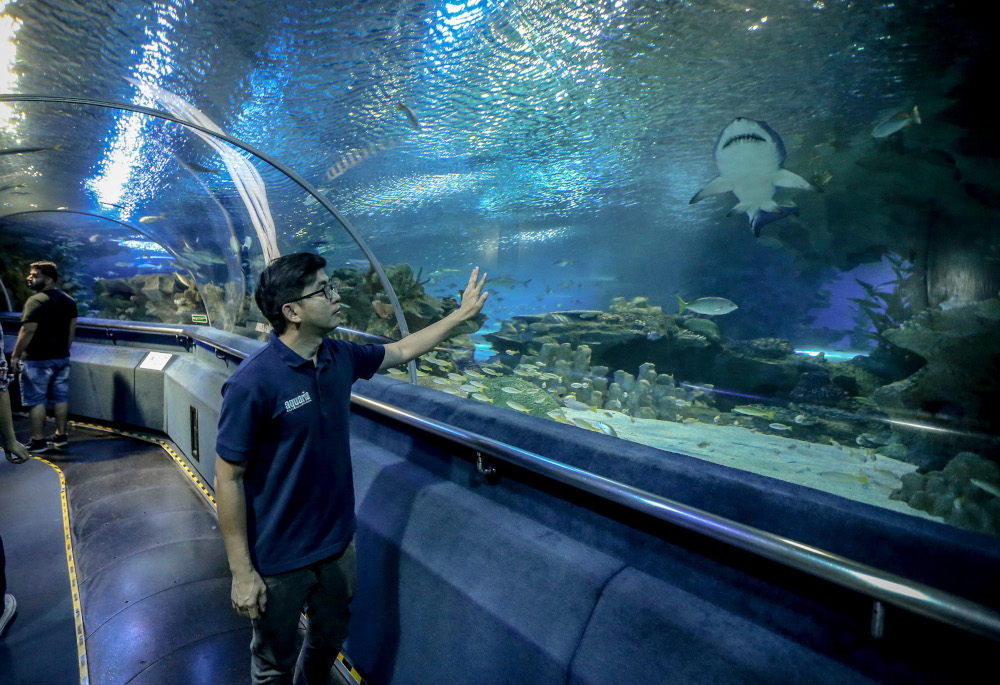KUALA LUMPUR, Feb 18 — Being part of a team that cares for Aquaria KLCC’s sea creatures is an uphill task.
Especially when it involves more than 5,000 of them including sand tiger sharks, green sea turtles, and arapaimas.
For this, there is Andrew Lee, the curator at Aquaria KLCC who holds the reins behind operations such as feeding, facility maintenance, upkeep of water quality, and animal husbandry at the aquarium.
“My work is very varied as I need to oversee the whole operation,” said Lee who has worked at the aquarium for more than eight years.
A typical workday for him begins bright and early at 7.30am with a morning briefing alongside his fellow aquarists.
He then supervises the team as they depart to their respective stations such as the feeding, cleaning, and quarantine sections.

As he walked us through the aquarium, we chanced upon one of the aquarists doing a feeding session with the Asian small-clawed otters who performed an adorable spin for their meal.
Lee explained that the otters had an instinctive tendency to spin around and the food reward simply reinforced the behaviour.
“We discovered that this is a move that they like to do naturally, we didn’t specifically train them to do it,” said the curator.
A sharp eye for detail helps Lee to keep tabs on the animals and this includes maintaining harmonious relationships between the sea creatures.
In the Living Ocean exhibit, he explained how the sand tiger sharks were the first animals to be introduced into the tank and trained to receive food from the divers.
This was carried out to stop the sharks from hunting and allow their diets to be controlled and monitored by the aquarists.
A net inside the tank separates the big carnivores from the flying rays and reef fishes.
“Sharks are the top predator in the food chain and we need to take precautionary steps to ensure the safety of other aquatic life,” said Lee.
Meanwhile, the green sea turtles are known to be more affable when it comes to life in the aquarium.
“The turtles are more friendly and accepting towards humans as well. Most of the time, they just like to rest at their own spots,” he said.
While strolling through the underwater tunnel, we catch one of the divers performing cleaning duties in the tank with a vacuum.
As the device operated, the diver playfully blew a ring of bubbles towards the visitors on the other side of the tank.
“Besides doing their regular duties, we encourage our divers to entertain the guests as well,” Lee noted.
While he runs a tight ship at the aquarium, Lee said that keeping things smooth sailing isn’t always easy as the aquarists have to be on the alert for emergencies that require immediate attention.
“We need to be on standby in case of an emergency or if one of the fishes falls sick. When that happens, we need to dive into the tank and get the fish out (to be quarantined).
“Occasionally, the system also requires us to come at night to kickstart it back up again,” explained Lee.
Keeping things spick and span is of critical importance especially with so many animals with different needs under the aquarium’s care.
This results in a lot of blood, sweat, and tears being shed on the other side of the tanks, unbeknownst to patrons.
“The maintenance and cleaning is the toughest part. We need to breeze through it before operations begin at 10am.
“I think that’s something that visitors don’t get to see because a lot of the cleaning takes place before opening hours,” said Lee.
Despite the hard labour, it’s all worth it for the marine science graduate from Universiti Malaysia Sabah who has cultivated a lifelong passion for aquatic life.
“I like fishes and I get to keep a lot of them at the aquarium. At the same time, I get to make it my job and I’m surrounded by so many beautiful and impressive fishes every day,” he said.

























